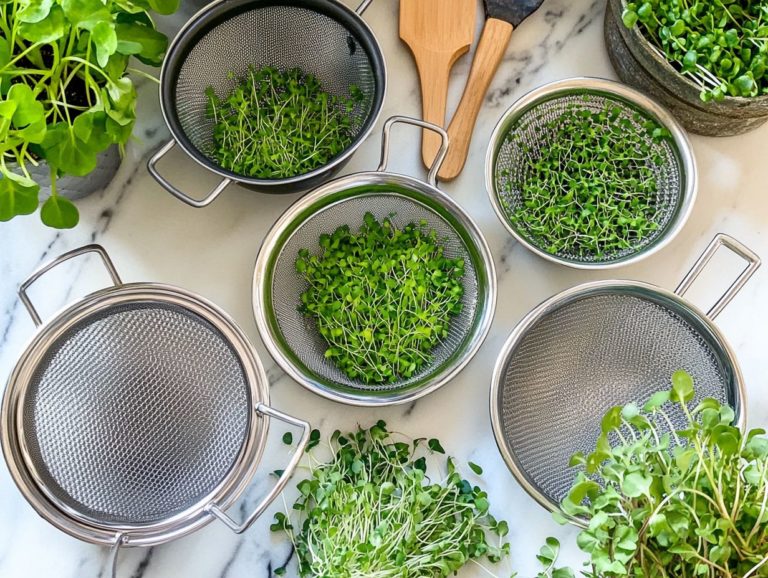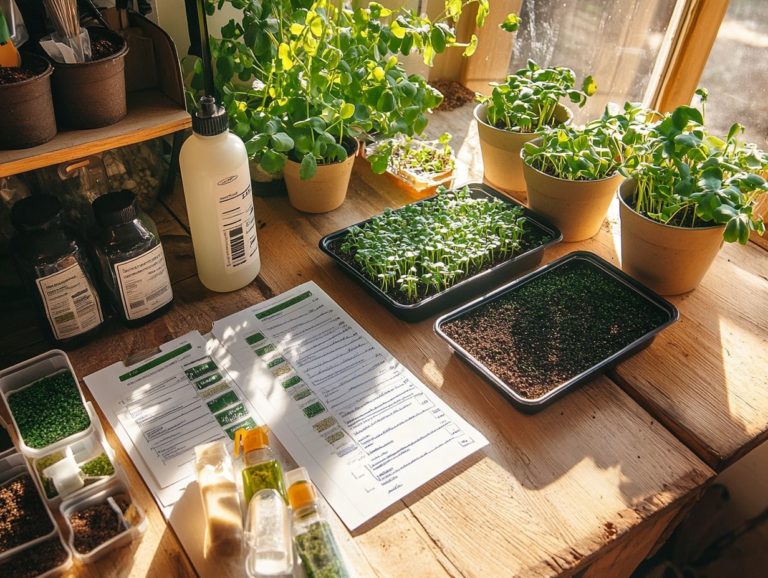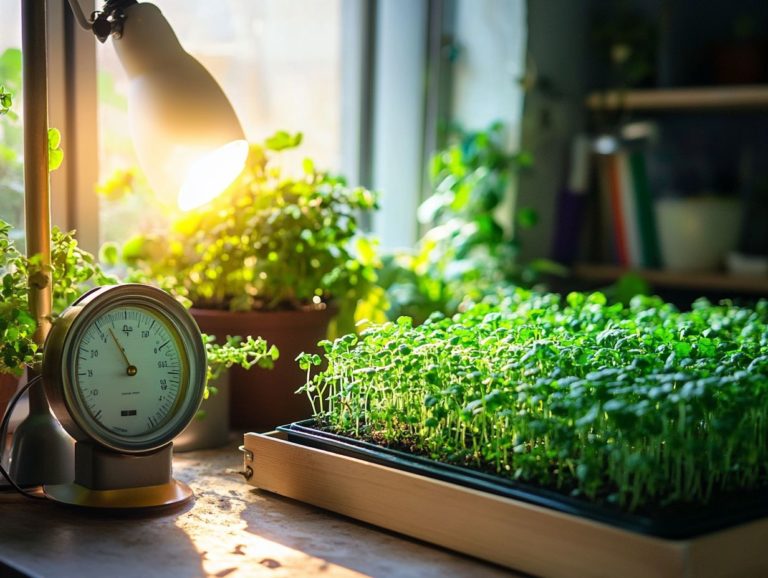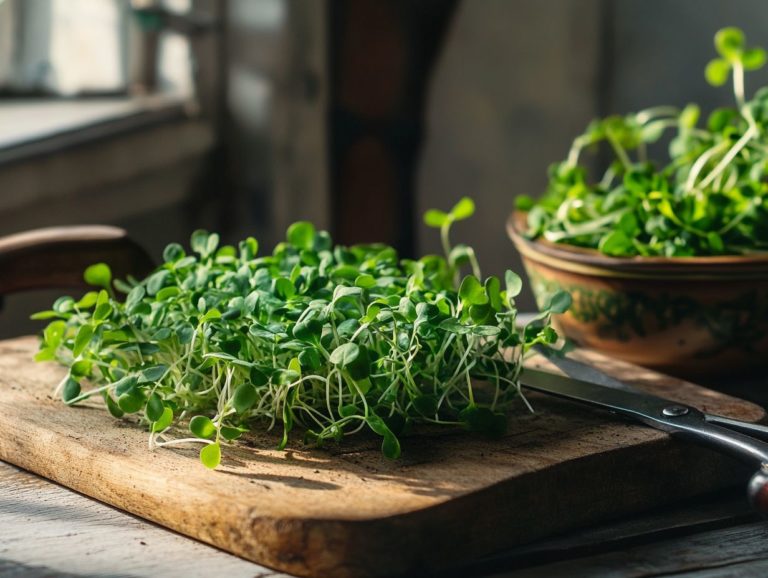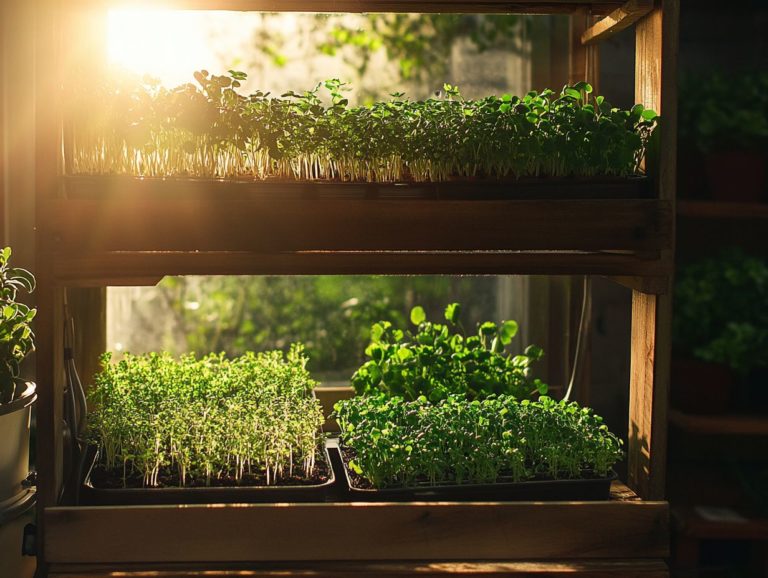Understanding Microgreen Seed Germination
Microgreens have carved out a special place in home gardens and cooking, adored for their vibrant flavors and remarkable health benefits.
This article delves into the world of microgreens, uncovering their unique attributes and the advantages they offer. You ll discover how to grow them from seed, exploring the nuances of seed germination while also receiving expert tips on selecting the ideal seeds.
Step-by-step guidance will be provided, empowering you to nurture your microgreens from the ground up. It will also address common challenges you may face. Whether you re a seasoned gardener or just starting to explore your green thumb, you ll find valuable insights to help you successfully cultivate these easy to grow and nutrient-dense greens.
Contents
Key Takeaways:
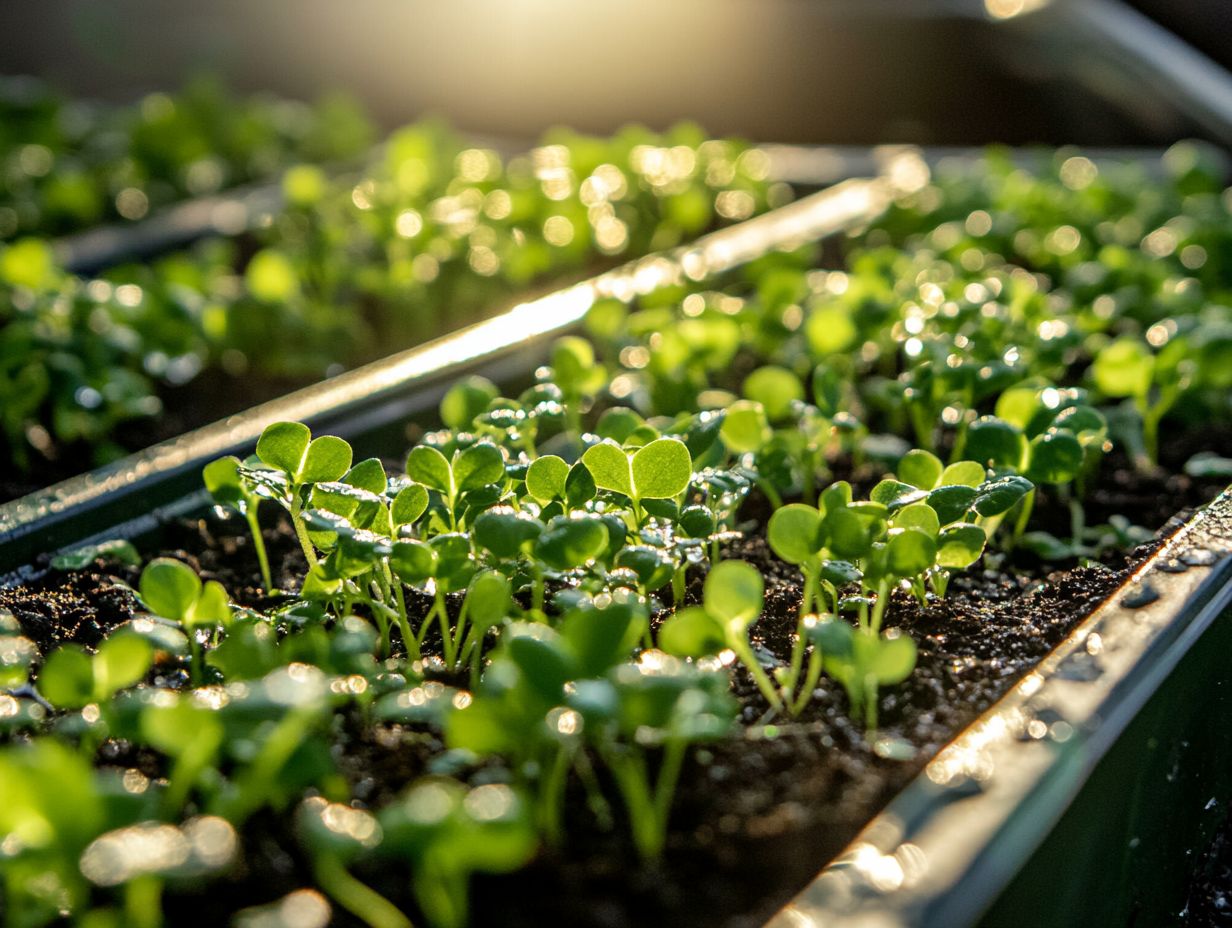
- Microgreens are young, nutrient-dense plants that can be easily grown at home.
- Growing microgreens is a cost-effective way to boost your nutrition and add flavor to your meals.
- Understanding the germination process and choosing the right seeds are crucial for successful microgreen growth.
What are Microgreens?
Microgreens are young, edible plants that you harvest right after their first true leaves emerge, bursting with flavor and vibrant colors, and a multitude of health benefits, including compounds like sulforaphane, a compound that may help fight disease.
These tiny greens are packed with nutrients think varieties like broccoli, kale, peas, and arugula. They ve captured the attention of urban gardeners thanks to their simplicity in cultivation and culinary adaptability. They re not just a feast for the eyes; they re also a treasure trove of vitamins and antioxidants, making them an essential addition to any healthy kitchen, perfect for promoting wellness and combating chronic disease.
Definition and Uses
Microgreens are the young seedlings of edible vegetables and herbs, harvested just after sprouting. They hold a prominent place in the culinary world due to their remarkable flavor and nutritional benefits.
These vibrant greens don t just add color to your plate; they are incredibly versatile in a myriad of recipes. Imagine incorporating them into salads, where their delicate textures and intense flavors create a delightful contrast that elevates the entire dish. You can also use microgreens to enhance sandwiches and wraps, providing a fresh, crunchy topping that transforms the overall taste experience.
Not only are they visually appealing and flavorful, but these tiny powerhouses offer a concentrated source of vitamins and antioxidants that contribute significantly to a healthy diet. By weaving microgreens into your daily meals, you can boost your overall wellness! They are a fantastic addition to both gourmet creations and everyday fare.
Benefits of Growing Microgreens
Growing microgreens presents a wealth of advantages, elevating the nutritional profile of your meals while also delivering cost savings compared to store-bought greens. This makes them an attractive choice for those who prioritize health and wellness.
Nutritional Value and Cost Savings
Microgreens are celebrated for their remarkable nutritional value, often boasting higher concentrations of vitamins and antioxidants than their mature counterparts. This makes them a powerful ally in enhancing your diet.
These tiny greens are not just cute; they pack a significant punch, especially when comparing the amount of nutrients of microgreens to that of fully-grown vegetables. You’ll find vitamins C, E, and K, along with essential minerals like iron and calcium, all contributing to your overall health in ways you might not fully appreciate until you start incorporating them into your meals. The concentrated nutrient density of microgreens allows you to experience the benefits of leafy greens without needing to consume large servings.
Growing your own microgreens can lead to substantial savings over time. Store-bought varieties can hit your wallet hard, but by cultivating these versatile plants at home in containers, you can enjoy fresh, nutrient-rich greens while slashing your grocery expenses. It s not just a health choice; it s a financially savvy one too.
Ready to start your microgreen gardening adventure? Let s get planting!
Understanding Seed Germination
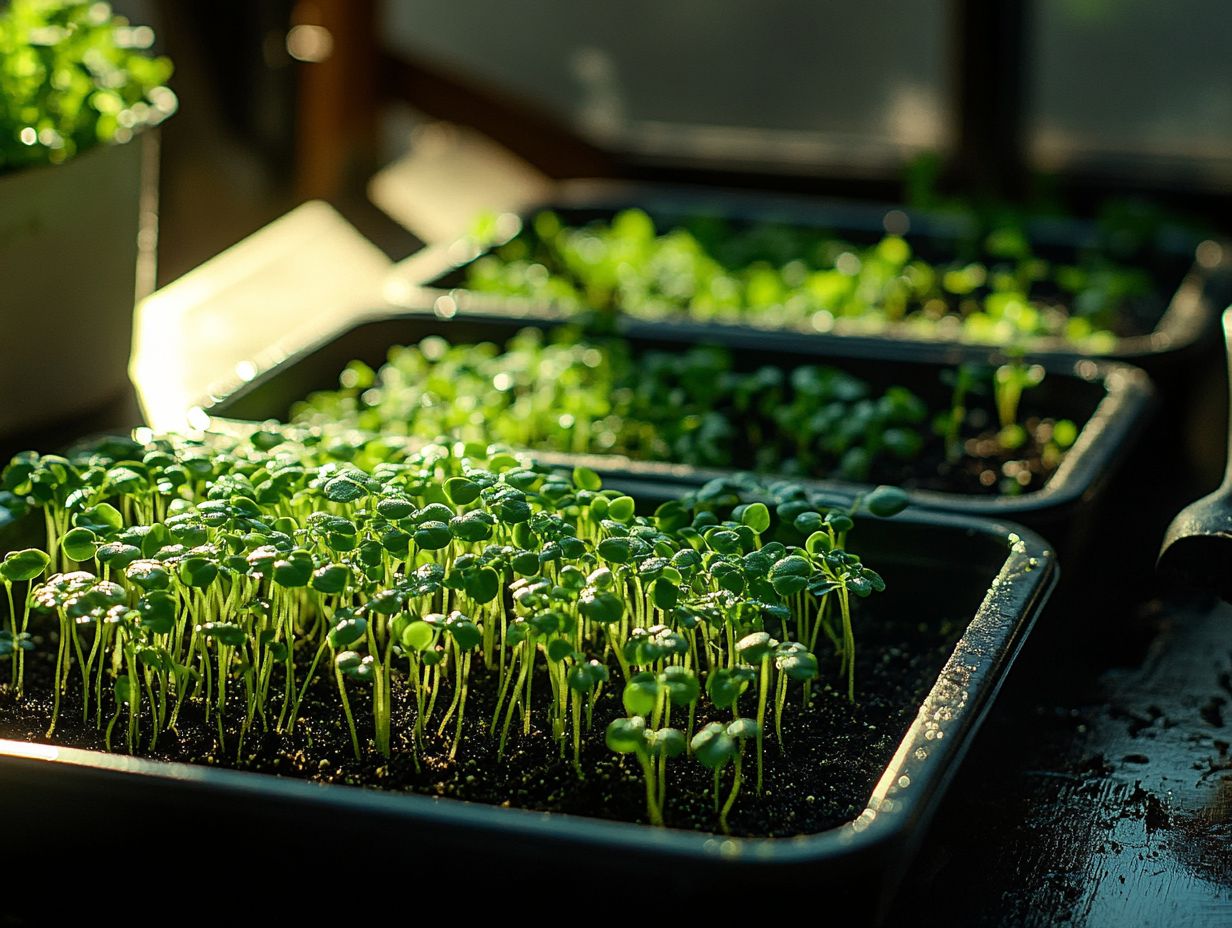
Understanding seed germination is essential for your success in growing microgreens, especially when applying the blackout method. It encompasses the detailed process of sprouting seeds under optimal environmental conditions, such as the right moisture levels and nutrient availability.
These factors can profoundly impact the health and growth of your microgreens, ensuring a bountiful yield and strong deep roots. To choose the right varieties, learn about what seeds can I use for microgreens?
Process and Factors Affecting Germination
The germination process is shaped by various factors, including moisture levels, temperature, and light conditions. All of these are pivotal in breaking seed dormancy, which is the sleeping state of seeds that prevents them from growing until conditions are right, and ensuring successful sprouting.
Moisture is crucial; seeds need water to activate the enzymes essential for growth and to maintain consistent moisture levels in your growing media. Temperature also plays a significant role in metabolic processes, with many seeds favoring warmer conditions. For example, broccoli seeds germinate best at 65-75 F, while kale seeds prefer slightly cooler temperatures, around 50-70 F. Additionally, understanding the timing of microgreen harvest can help optimize your growing results.
Light also plays a key role in germination. Certain species, like lettuce, require exposure to light to kickstart sprouting, whereas others, such as broccoli, can germinate in darkness. Grasping these diverse requirements is essential, whether you’re a gardener or a farmer, as it can significantly impact your crop yield. Utilizing sprouting trays for microgreens can also enhance your growing success.
Choosing the Right Seeds for Microgreens
Choosing the perfect seeds can make your microgreens thrive! Each type of seed, whether it be broccoli or radish, brings its own distinct flavors and nutritional benefits, catering to a variety of culinary preferences.
By selecting wisely, you can elevate your dishes and enhance your cooking experience.
Types of Seeds and Best Practices
In terms of growing microgreens, you have a wealth of seed options at your fingertips, including amaranth, chia, and buckwheat. Popular choices like broccoli, kale, arugula, and radish each bring their own unique flavors and characteristics to the table.
But don t stop there; consider adding basil for a sweet, aromatic kick or mustard greens for that delightful peppery zing. Each seed type not only varies in taste but also in how you might use them think salads, sandwiches, or as a stylish garnish for hearty dishes.
To achieve optimal growth and flavor, it’s essential to plant these seeds in nutrient-rich soil while ensuring consistent moisture and adequate light. Take advantage of window light for indoor growing. By regularly monitoring humidity levels and keeping the temperature around 70 F, you can significantly enhance their growth rate and flavor profile. For more insights, check out understanding the growth patterns of microgreen varieties, leading to a bountiful and delicious harvest.
Steps for Successful Microgreen Seed Germination
To achieve successful microgreen seed germination, you need to focus on a few key steps, including pre-blackout steps for optimal germination.
- Start by preparing the growing media with care, ensuring it s just right for your seeds.
- Maintain adequate moisture levels, as this is crucial for the germination process.
- Finally, ensure optimal seed-to-soil contact, which is essential for effectively sprouting seeds in your home microgreens.
Get started on your microgreen journey today!
Preparing Seeds and Growing Medium
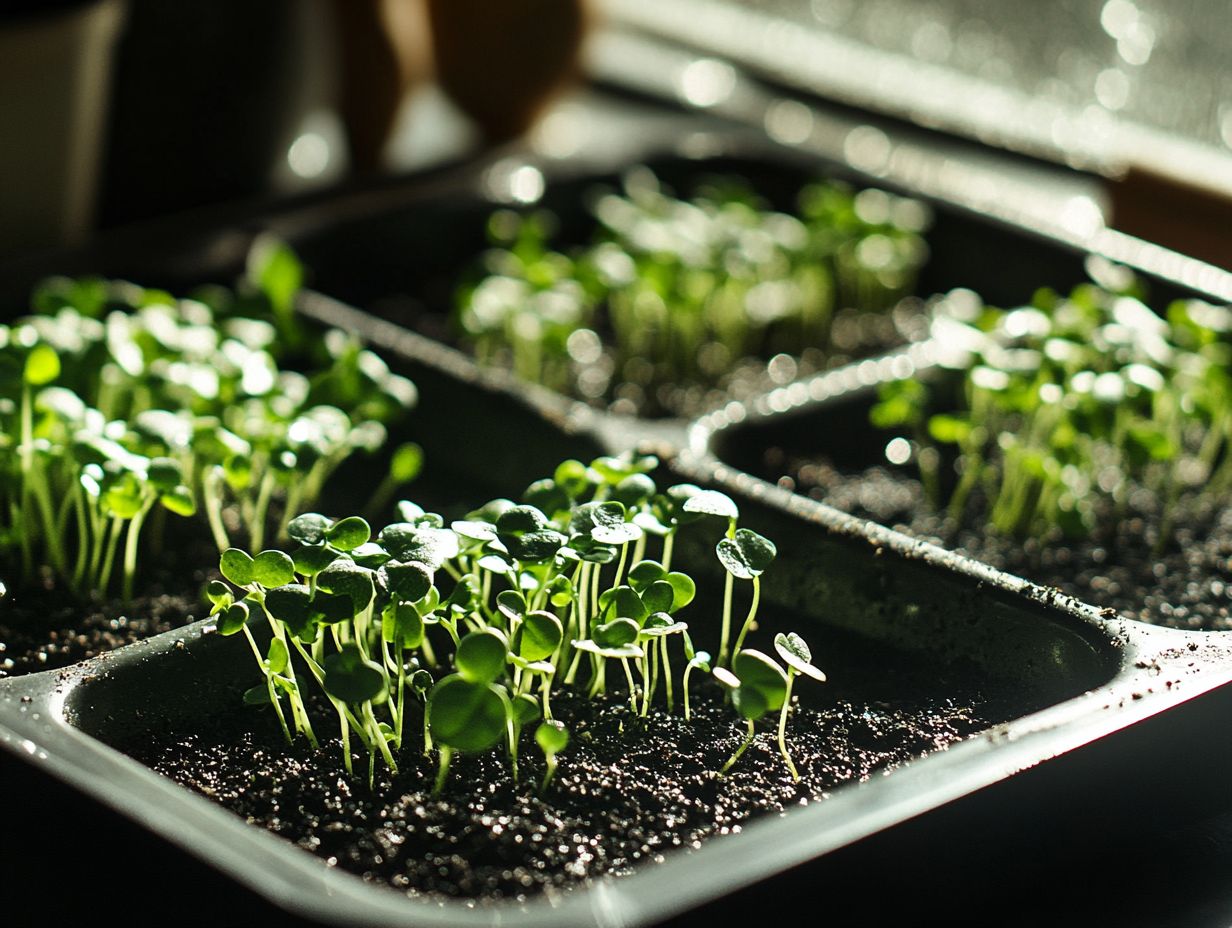
Get ready to see your microgreens thrive! Proper seed preparation sets the stage for a fantastic harvest. Preparing seeds and selecting the right growing medium is a fundamental step in the germination process. This ensures that your seeds receive the optimal moisture and nutrients essential for successful germination.
The type of growing medium you choose can significantly impact the health and growth of your microgreens. Options like coconut coir, peat moss, and vermiculite each offer unique benefits, such as excellent drainage and a perfectly balanced pH, which is crucial for maintaining quality. To ensure you are getting the most out of your microgreens, it’s also important to understand their shelf life.
The methods you use to prepare your seeds like soaking them to soften seed coats and rinsing to eliminate potential contaminants are key to enhancing germination rates. Don’t overlook keeping the right moisture levels; maintaining this is crucial to preventing soggy conditions that can hinder growth or even lead to rot.
By understanding and implementing these practices, you can greatly increase your chances of enjoying a robust microgreen harvest.
Caring for Germinating Seeds
Caring for germinating seeds is essential for their success. This demands your careful attention to moisture levels, air circulation, and overall environmental conditions to foster healthy growth.
Striking the right balance among these elements is crucial; too much moisture can lead to mold or soggy conditions, which poses a serious threat to development. Aim to keep the growing medium consistently moist but not soggy, using gentle watering techniques like a spray bottle to hydrate them without overwhelming their delicate roots.
To ensure adequate air circulation, consider using fans or creating small ventilation holes in your containers. This allows fresh air to flow and reduces humidity build-up. Pair this with the right lighting ideally a mix of natural sunlight and indoor growing lights to further nurture their growth, transforming those tiny seeds into thriving plants.
Troubleshooting Common Issues
Troubleshooting common issues during microgreen germination can greatly enhance your growth outcomes. Addressing problems related to moisture, light, and air circulation is crucial, as these things can slow down seed growth and compromise overall health.
By taking the time to fine-tune these elements, you can create an optimal environment for your microgreens to thrive.
Identifying and Addressing Problems
Identifying and addressing issues in your microgreen growing process is essential for ensuring healthy development and achieving optimal yields. Pay special attention to factors like moisture levels, light exposure, and air circulation.
For instance, overwatering can lead to root rot, which often presents itself as yellowing leaves or a mushy stem. To combat this, you should regularly check the soil’s moisture content and allow it to dry slightly between waterings.
On the other hand, inadequate light can cause your seedlings to stretch excessively toward the light source, resulting in weak, leggy plants. Positioning them under a balanced grow light for 12-16 hours each day can effectively resolve this issue.
Poor air circulation can trigger mold growth and negatively impact plant vitality. Using a small fan or ensuring proper spacing can help maintain good airflow, creating a healthier environment for robust growth.
Frequently Asked Questions
What is microgreen seed germination?
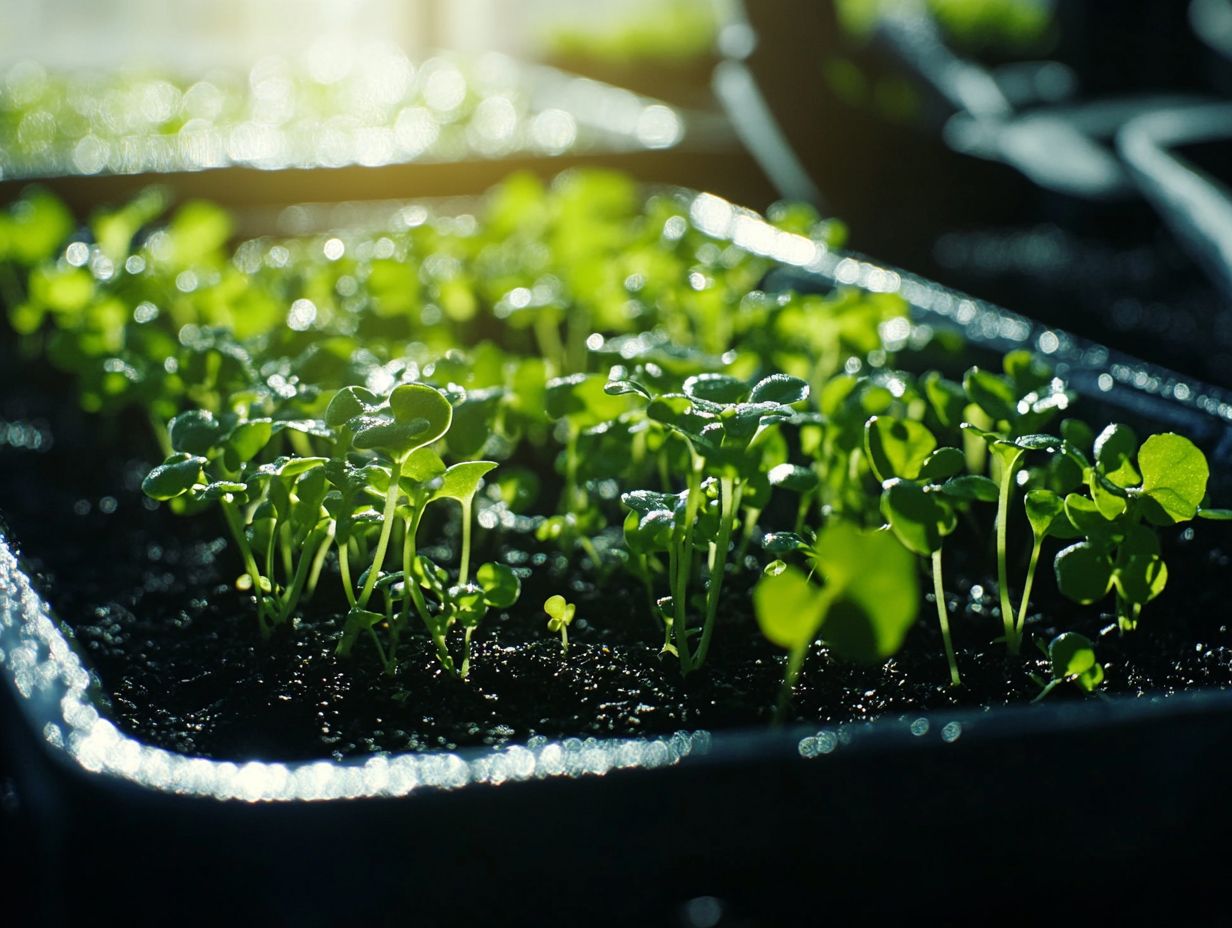
Microgreen seed germination is the process of sprouting small, young plants from seeds. These plants are harvested at a very early stage, typically within 1-3 weeks of sprouting.
Why are microgreens popular?
Microgreens are popular because they are packed with nutrients and can be grown quickly and easily at home. They also add a burst of flavor and color to dishes, making them a favorite among chefs and health-conscious individuals.
What types of seeds can be used for microgreen seed germination?
You can use any herb, vegetable, or flower seed for microgreen germination. Popular choices include broccoli, kale, radish, and sunflower seeds.
How do you germinate microgreen seeds?
Start by soaking the seeds in water for a few hours. Then, spread them evenly on a planting surface like soil or a hydroponic mat.
Keep the seeds moist and in a warm, dark place until they sprout. Afterward, move them to a brightly lit area to continue growing.
How long does it take for microgreen seeds to germinate?
The germination time varies by seed type and growing conditions. Most microgreens will sprout within 3 to 7 days.
Are there any special considerations for germinating microgreen seeds?
Yes, there are several important factors to consider. Use high-quality, organic seeds and maintain a clean environment to prevent mold.
Proper watering and good lighting are essential for healthy growth!

